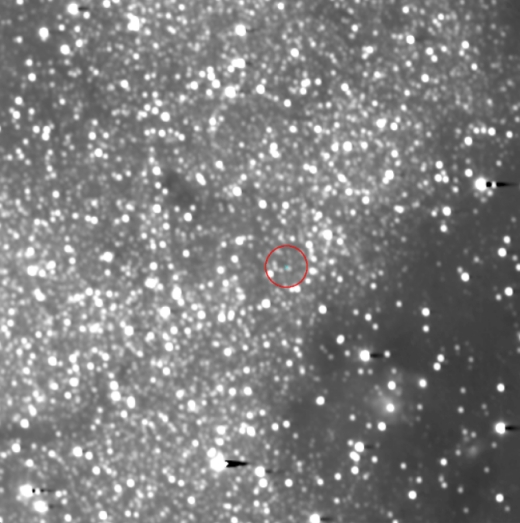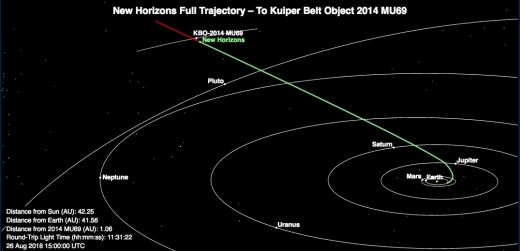Here’s another, wider look at New Horizons’ view of Ultima Thule (MU69), its next target, which we first saw in late August, though the image was acquired at mid-month. I like this view because it gets across just what a tricky acquisition this was. Look at the background star-field! Consider that Ultima is still 100 times fainter than Pluto as seen from Earth, making it about a million times fainter than a naked eye object. LORRI, the spacecraft’s Long Range Reconnaissance Imager, once again demonstrates its key role in the mission.

Image: New Horizons spotted Ultima Thule for the first time on August 16, near the center of the red circle in this LORRI image of the dense Milky Way star field where Ultima lies. Credit: JHU/APL.
Getting the image as early as it did was something of a coup for New Horizons, this being the first attempt, made just after the spacecraft transitioned from spin-stabilized mode (during cruise) to pre-flyby mode, which allows its cameras and other instruments to point as needed. According to New Horizons’ PI Alan Stern, the detection images were returned to Earth on August 18-19, where they received the necessary processing to remove artifacts. Says Stern:
Scientists on our team in Maryland, Arizona, and Colorado jumped right onto those data, carefully processing them to remove background stars and other artifacts — and out popped Ultima, a faint beacon, dead ahead, in just the very pixel our navigation crew had predicted it would show up!
Useful work indeed, allowing regular imaging from the spacecraft to refine New Horizons’ course. We learn in Stern’s latest report that the team plans to execute a course correction on October 3, affecting the craft’s trajectory by about 3 meters per second, so the team is already fine-tuning approach and arrival parameters. As part of future course refinements, remember that we now have data from the occultations of a background star by Ultima that occurred on August 3-4, events that were observed by teams in Senegal and Colombia. For more on this and the previous occultation work in Patagonia, see On to Ultima Thule.
We can anticipate a full update from mission scientists at the 50th annual meeting of the Division for Planetary Sciences, coming up in late October in Knoxville, TN, where new results from Pluto/Charon will also be discussed. Right now, the search for collision hazards near Ultima continues as does navigation imaging of the target, which could well lead to future course-corrections. Although no hazardous debris has yet turned up in the occultation data, November and December will see the LORRI instrument scanning the target intensely at closer range. And Ultima Thule isn’t the only KBO in the mix, as Stern reports:
New Horizons will collect data on a half-dozen other Kuiper Belt objects and the plasma and dust environment way out there in the Kuiper Belt, nearly 4 billion miles from Earth. Also, our flight team will be finalizing the software loads to drive the spacecraft’s close-up flyby observations of Ultima and its environment, from geology to composition, to searches for moons, rings and any atmosphere Ultima may sport.
And for another sense of scale, the image below views New Horizons’ current position in relation to the rest of the Solar System. Now would be a good time to read, if you haven’t already, Stern and David Grinspoon’s Chasing New Horizons (Picador, 2018). In the book, the authors discuss how critical pre-flyby planning and maneuvers were to get the spacecraft to arrive at closest approach to Pluto/Charon within the tight window (9 minutes!) necessary for all the spacecraft’s programmed pointing maneuvers to center its targets.

Image: New Horizons has crossed almost all of the 1.6 billion kilometers (1 billion miles) separating the July 14, 2015, flyby of Pluto and the upcoming January 1, 2019, flyby of the Kuiper Belt object (KBO) nicknamed Ultima Thule. Credit: JHU/APL.
What Stern tells Grinspoon here is just as germane to the approach to Ultima Thule:
Much of how New Horizons achieved this goal was done with careful optical navigation and rocket-engine firings that the spacecraft performed to home in on the closest-approach time. But mathematical analysis had shown that this alone might not be good enough to guarantee arrival in the critical plus-or-minus 540 second window. So the spacecraft’s engineers at APL also built in some clever software to correct for any remaining timing errors once it was too late to fire the engines.
The importance of the optical information is likewise clear:
As the spacecraft approached Pluto, every day the optical navigation team used new images to determine just how far off the closest approach timing was going to be, and then calculated the timing knowledge update needed to correct for that. Concurrently, Leslie Young and her encounter planning team used sophisticated software tools to generate a ‘science consequences report,’ in which each close-approach observation was simulated for the newly predicted timing error to determine, assuming no correction was made, which would succeed and which would fail.
For the Ultima Thule encounter, the New Horizons team is conducting mission simulations and working through procedures for over 250 possible spacecraft contingencies should problems arise (as part of that effort, new fault protection software has already been uploaded). With the journey from Pluto/Charon to the KBO now 90 percent complete, we can look forward to the New Year’s Eve flyby, followed by further data acquisition from the Kuiper Belt beyond.



https://arxiv.org/abs/1808.07446
A White Paper on Pluto Follow On Missions: Background, Rationale, and New Mission Recommendations
Richard Binzel, Will Grundy, Doug Hamilton, Rosaly Lopes, Bill McKinnon, Cathy Olkin, Stuart Robbins, Alan Stern
(Submitted on 22 Aug 2018)
The exploration of the binary Pluto-Charon and its small satellites during the New Horizons flyby in 2015 revealed not only widespread geologic and compositional diversity across Pluto, but surprising complexity, a wide range of surface unit ages, evidence for widespread activity stretching across billion of years to the near-present, as well as numerous atmospheric puzzles, and strong atmospheric coupling with its surface.
New Horizons also found an unexpected diversity of landforms on its binary companion, Charon. Pluto’s four small satellites yielded surprises as well, including their unexpected rapid and high obliquity rotation states, high albedos, and diverse densities.
Here we briefly review the findings made by New Horizons and the case for a follow up mission to investigate the Pluto system in more detail.
As the next step in the exploration of this spectacular planet-satellite system, we recommend an orbiter to study it in considerably more detail, with new types of instrumentation, and to observe its changes with time.
We further call for the in-depth study of Pluto orbiter missions as a precursor to the 2023 Planetary Science Decadal Survey.
Subjects: Earth and Planetary Astrophysics (astro-ph.EP)
Cite as: arXiv:1808.07446 [astro-ph.EP]
(or arXiv:1808.07446v1 [astro-ph.EP] for this version)
Submission history
From: Stuart Robbins [view email]
[v1] Wed, 22 Aug 2018 17:20:29 GMT (2586kb)
https://arxiv.org/ftp/arxiv/papers/1808/1808.07446.pdf
I don’t see yet how this would be feasible, but while Pluto/Charon is fascinating… wouldn’t we potentially learn more by going to Neptune/Triton? It would definetly be easier to achieve orbit there.
Agree that orbit around Pluto will be difficult, but some study have shown it can be done. Also that Neptune & Triton need a better look.
If we are to learn more is first goal, flyby missions of 2015 RR245, Haumea, Makemake, Orcus, Varuna and Quaoar might be done first.
(Perhaps not Eris, inclination 44 degrees and 25 year mission then with Jupiter flyby.) Even if only few of these get a flyby, we would get fantastic information. Haumea might be more crazy than Pluto 14,5 – 16,5 years for a probe, and a mission to Quaoar could take 13,5 for a flyby that also would study the heliosphere as the probe leaves the solar system.
I would expect the combination of the Kilopower/Megapower reactor & some sort of electric drive would make any of these missions a lot easier.
@ Andrei – thnx for the reply. – With orbital insertion around Pluto the approach needs to be really slow, or you have to bring a lot of fuel (the main reason new Horizons is so small) (new tech will help)
As such another flyby of Kuijpers belt objects would be the realistic option (I think) it would be great if there would be a path so this mission could visit a string of Kuijper belt objects, the technique for a flyby is a proven one.
(When orbit around Pluto can be achieved the mission should last at least several decades: geological changes and any kind of weather will be very slow for our human eyes.)
I notice that Ultima Thule is tinted blue in the New Horizons photo. Is that from the real color of the KBO, or did someone add it to make the object stand out against all those stars?
It seems to me that this must be close to the limit of probe control from Earth. At some point, probes should just be given general commands which the craft then executes using onboard sensors and software to achieve. This is clearly going to necessary for interstellar probes to make suitable close flyby approaches to exoplanets.
Do we have any ideas about the parameters for transitioning from Earth-based to probe-based navigation?
There was talk about a third flyby mission after Ultimate Thule, but no object has yet been found an probably won’t until James Web comes online. Is there a realistic chance an object will be found? The further out the smaller the possible target area get’s, so I assume the earlyer an object is found the better… Hubble to the rescue once more?
In the lead up to the approach to Pluto the search for an flyby candidate was quite frantic, now there’s hardly talk about it while it was then required to get funding for an extended mission, are such considerations not in play now? (I’m curious about the scenario’s after this flyby, but maybe i’m just too impatient)
They will have to find a suitable KBO before 2030, because that is when the New Horizons’ RTGs become too weak to power the deep space probe sufficiently for science operations.
Voyager 1 an 2 will also last until around 2030, but I am not sure if they have either sufficient energy or a viable target to examine their own KBOs.
Thnx, that gives James web plenty time to find something, but with an ever decreasing angle to choose from… the further out the more interesting a target will get of course…
See as the JWST won’t launch until 2021, and will then require months of calibrations and testing before it becomes a fully operational astronomical satellite – and we have to hope the launch date isn’t pushed out any further – we should instead rely on the telescopes we have currently operational to us for such a project.
A. I totally agree with Paul. If you havn’t read Chasing New Horizons, you should. Great book.
B. A Pluto orbiter would be outstanding. However, after reading the follow on missions paper, there is no need for a gold-plated multi-billion dollar mission. Basically, send an up-to-date version of New Horizons. Build three of the New Horizons Mark II and send the other two to orbit Neptune and Uranus.
Jason Davis • September 19, 2018
‘Everything about this flyby is tougher’: New Horizons just over 100 days from Ultima Thule
http://www.planetary.org/blogs/jason-davis/2018/nh-ut-100days.html